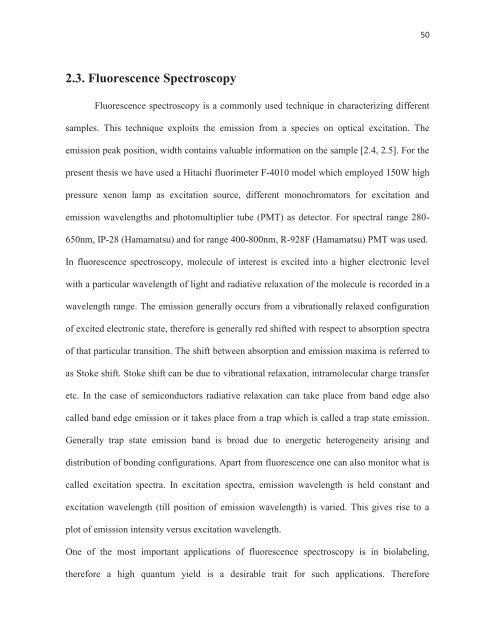CHEM01200604009 Sreejith Kaniyankandy - Homi Bhabha ...
CHEM01200604009 Sreejith Kaniyankandy - Homi Bhabha ...
CHEM01200604009 Sreejith Kaniyankandy - Homi Bhabha ...
Create successful ePaper yourself
Turn your PDF publications into a flip-book with our unique Google optimized e-Paper software.
50<br />
2.3. Fluorescence Spectroscopy<br />
Fluorescence spectroscopy is a commonly used technique in characterizing different<br />
samples. This technique exploits the emission from a species on optical excitation. The<br />
emission peak position, width contains valuable information on the sample [2.4, 2.5]. For the<br />
present thesis we have used a Hitachi fluorimeter F-4010 model which employed 150W high<br />
pressure xenon lamp as excitation source, different monochromators for excitation and<br />
emission wavelengths and photomultiplier tube (PMT) as detector. For spectral range 280-<br />
650nm, IP-28 (Hamamatsu) and for range 400-800nm, R-928F (Hamamatsu) PMT was used.<br />
In fluorescence spectroscopy, molecule of interest is excited into a higher electronic level<br />
with a particular wavelength of light and radiative relaxation of the molecule is recorded in a<br />
wavelength range. The emission generally occurs from a vibrationally relaxed configuration<br />
of excited electronic state, therefore is generally red shifted with respect to absorption spectra<br />
of that particular transition. The shift between absorption and emission maxima is referred to<br />
as Stoke shift. Stoke shift can be due to vibrational relaxation, intramolecular charge transfer<br />
etc. In the case of semiconductors radiative relaxation can take place from band edge also<br />
called band edge emission or it takes place from a trap which is called a trap state emission.<br />
Generally trap state emission band is broad due to energetic heterogeneity arising and<br />
distribution of bonding configurations. Apart from fluorescence one can also monitor what is<br />
called excitation spectra. In excitation spectra, emission wavelength is held constant and<br />
excitation wavelength (till position of emission wavelength) is varied. This gives rise to a<br />
plot of emission intensity versus excitation wavelength.<br />
One of the most important applications of fluorescence spectroscopy is in biolabeling,<br />
therefore a high quantum yield is a desirable trait for such applications. Therefore
















